| |
| |
| |
| |
| |
| |

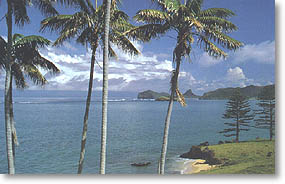
Where is Lord Howe Island?
LORD HOWE ISLAND is a sub tropical island of volcanic origin eleven
kilometers in length that lies 550 kilometers east of Port Macquarie,
about 700 kilometers north-east of Sydney (Lat. 31.55 S and 159.09 E). This beautiful island is one
of the first three islands in the world to be given the status of "World
Heritage" due to its unique plant and animal life.Home to the worlds
most southern coral reef Lord Howe is home to over 500 species of fish,
90 types of coral and 130 species of birds. For more on LHI try "Lord Howe Island for beginners" and Trader's Nick page.
Here is the
weather forecast.
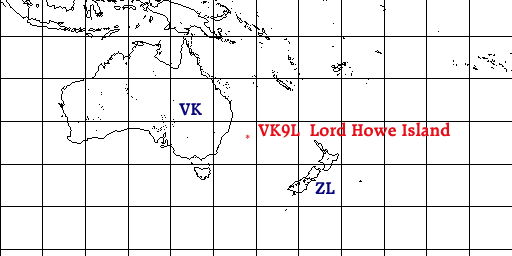
The team of operators for the VK9LX Lord Howe operation consists of the team leader Nick, VK2ICV, and four yanks: Ray, N4RU, Bill K6KM, Mary Lou NM7N and Charlie N0TT. Here are a few words about each:
Nick Hacko, VK2ICV has been known to the world for years as YU7XX and editor of 'Who's Who on the TopBand' . He has been a ham since '79. Nick is a former contest operator at stations YU1EXY and 4N7A, and was many times the YU Contest champion. Nick led the contest DXpedition to Lord Howe in 1997, competing in the CQWW CW contest.
Ray Smolenski, N4RU / VK9LRU has been a ham since '59. Ray's many DX accomplishments (DXCC Honor Roll, 5BDXCC, et al) from his home station were achieved using 100 watts output to simple antennas at low elevation. He has contributed to the success of multi-single contest station WA4LZR many times. This will be a repeat trip to Down Under for Ray as he has operated previously as ZL0ACH.
For Bill Snider, K6KM, a ham since '49, this will be on his first multi single operation in many years. He was one of ten ops at the Willis Island (VK9WM, VK9WY) operation in September '97. His home station is no stranger to major DX and domestic contests. Bill operated numerous contests as EP2SV/9D5A in the '70s and has recently operated from TI2, TI4, OH2, OH0, M (G), and ZL.
Mary Lou Brown, NM7N / VK9LML is the newest ham (since '81) but has a huge amount of DXpedition and contest experience. She has led DXpeditions (all YL) to Niue, Wallis, British Virgin Islands, Grenada, St. Pierre et Miquelon, Anguilla, American Samoa and again to Anguilla! She has operated numerous QRP contests and Field Days, a couple RTTY Round-Ups and a few CQWW-CW contests.
Charlie Hansen, N0TT / VK9LTT a ham since '58, is a low band specialist and has been particularly successful in 160 meter contests. Charlie has been Section and Division leader in numerous 160M contests and topped the world in the 1997 ARRL 160 test, QRP! He has Dxpeditioned to VE8 for Sweepstakes and VE2/Zone 2 for the 1995 Radiosport contest.
Propagation Prediction Information
by Bob Brown, NM7M
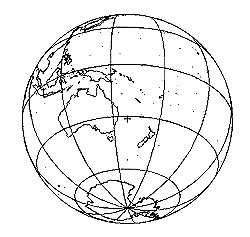 | 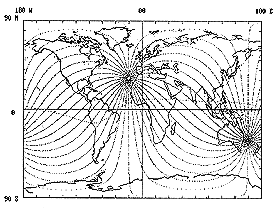 |
The first map demonstrates the splendid isolation of LHI, close to Australia and New Zealand but far removed from the major centeres of the amateur population. The second map gives quantitative expression to the first map as great-circle paths to antipode, near EA8, show that the pats from LHI in that direction are well beyond 10.000 km in length. The third set of maps are the GOOD NEWS as they show the two auroral zones and the fact that most of the world can be reached form LHI without going across either of the auroral zones or suffer any of the disruptions of propagation that may take place there.
 | 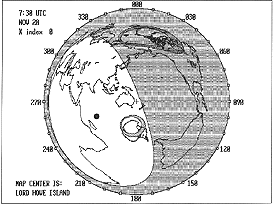 |
The USA is beyond the 10,000 km boundary so things will be more difficult there but not too bad. The difficult paths will be those toward Europe and considering their higher latitude, chances of working them on higher bands, 21 MHz and above, would seem pretty slim at this point. Of course, a sudden spurt of solar activity could provide the ionization and everything would be beautiful but without that, the "workinghorse band", 20 meters, would seem the best.
Those are the major centers of amateur radio population and will be where most of the contest Q's will come from. Of course, there is still South America, off to the east and beyond 10,000 km, and Oceania, nearby. Those should not be neglected but, face it, they will not be large sources of contacts in the contest.
As for the details, the first thing to look at is the times for sunrise and sunset at LHI. Those will determine the operating times on the lower bands, when darkness is required on the paths. So let's look at that, sunset at 0807 UTC and then sunrise at 1816 UTC. In the ten hours of darkness, operating times for various locatios are given below:
To the East of LHI, paths will be in darkness after sunset:
| Boston | 0807 to 1155 UTC | 15,500 km |
| New York | 0807 to 1202 UTC | 15,200 km |
| Philadelphia | 0807 to 1205 UTC | 15,100 km |
| Atlanta | 0807 to 1226 UTC | 14,200 km |
| Chicago | 0807 to 1300 UTC | 14,100 km |
| Omaha | 0807 to 1332 UTC | 13,400 km |
| Dallas | 0807 to 1313 UTC | 13,000 km |
| Salt Lake City | 0807 to 1434 UTC | 12,200 km |
| Los Angeles | 0807 to 1439 UTC | 11,300 km |
| Seattle | 0807 to 1543 UTC | 11,800 km |
| Poland | 1428 to 1816 UTC | 16,000 km |
| England | 1551 to 1816 UTC | 17,200 km |
| Spain | 1643 to 1816 UTC | 15,200 km |
As for higher bands, 21-28 MHz, those will be profitable in the immediate area of LHI and out to Japan as all the stations in that region of Oceania are at low latitudes, the most robust portion of the ionosphere. Beyond that, the question is one of timing and solar activity. Thus, in 3-hour intervals from 0000 UTC to 1200 UTC, the region illuminated by the sun covers Oceania, Asia, Asiatic Russia and Europe, in that order. That will have the effect of improving chances of contacts with those regions; however, the degree of success wll depend on the ham population in those areas. For example, Oceania and Asia have relatively small populations in amateur radio terms and while the bands may open up, the number of contacts might be marginal.
As for best times for paths to the East, say to the USA, those would be after sunrise when the sub-solar point is around the middle of a path; that would give pretty uniform illumination and ionization on a path. But with LHI at a lower latitude, it would be even better to think of making contacts when the sun is closer in longitude to the far terminus, thus helping to raise the level of ionization there and making it match that at Lord Howe Island.
For contacts to the West, say with Europe, paths would be open on the higher bands until about sunset at LHI, even a little beyond as that would have the sun to the west and raising the level of ionization at the high latitude end of the paths.
| time/band | 00-03 | 03-06 | 06-09 | 09-12 | 12-15 | 15-18 | 18-21 | 21-24 |
| 28 | OC | AS | EU / JA | EU | - | - | - | OC |
| 21 | JA / OC | JA / OC | JA / SA | EU / SA | EU | - | OC | OC |
| 14 | JA / OC | JA / OC | EU / OC | EU / JA | EU / ZS | EU / ZS | ZS / VK | VK |
| 7 | ? | ? | ? | EU / ENA | EU / MW | OC / WNA | ? | ? |
| 3.5 | ? | ? | ? | ENA / OC | JA / WNA | JA / EU | ? | ? |
| 1.8 | - | - | - | ENA | WNA | JA / EU | - | - |
OC - Oceania, AF - Africa, JA Japan, VK - Australia
The WARC Bands are not included in the band plan as they are not to used during contest. Their operation in non-contest times would be similar either to the next highest band, durin times of strong solar activity, or else the next lowest band.
The mid-day operation on 3.5 and 7 MHz is uncertain because of the nearby Australian ham population and the remotness of other DX sites from LHI. That time is one of the increased ionospheric absorption and may prove unproductive in those bands, with time better spent on higher bands where the solar illumination does some good.